essays
Jeff VanderMeer’s 12 Favorite Holiday Gift Books for 2014
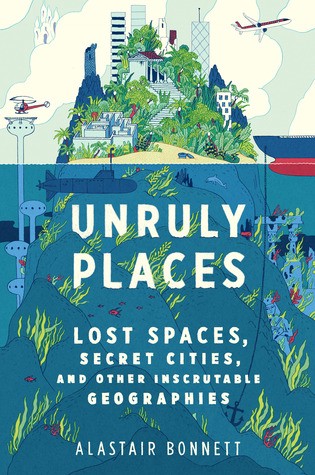
As noted in the preamble to my favorite fiction list, my reading in 2014 was rapacious but had no particular focus or methodology behind it. However, I must admit to a difference between my fiction and nonfiction reading. My fiction reading was wide and various while my nonfiction and art book selections had a more narrow focus. I mostly ferretted out books on subjects I am keenly interested in because of my own ongoing nonfiction projects. These subjects included maps, getting lost for no good reason, mixed martial arts, creativity, weird fiction, surrealism, and, um, Moomin-lore, because the Lord sure does love a Moomin and little old mortal me does as well. (If you don’t know what a Moomin is, read this.)
All of these books are great gifts for the general reader. Many, however, double as great gifts for the writer in your life.
NONFICTION

Want to know about pumice and trash islands? How about an island that didn’t exist but appeared on U.S. Navy maps for decades? Or the Archaeological Park of Sicilian Incompletion? Yes? Well, then, you’ve come to the right book. Bonnett not only knows how to coax the most interesting storyline out of his subject matter but comes to this endeavor with a definite point of view. So when Bonnett explores lost feral places and forgotten islands, he’s almost inevitably expressing the idea that we need to be able to get lost every once in a while — that knowing exactly where we’re at all the time is a liability and blunts some important curiosity or impulse. At the same time, Bonnett’s telling us the world we think we know is more of an artificial construct than we realize, although he does it without ever condescending or lecturing. There have been other books on this subject but this one is the best written and most compelling. Prepare to be disoriented…and re-oriented.

Born to Fear: Interviews with Thomas Ligotti edited by Matt Cardin (Subterranean Press)
If you haven’t heard of Ligotti, all you need to know is that he’s a protean talent in weird fiction comparable only to Kafka and Poe. He’s by far one of the best short fiction writer of the past 25 years, along with Caitlin R. Kiernan, and also fascinating in his interviews. Earlier this year I wrote about him over at Vulture, in part due to a controversy involving the TV show True Detective. Because Ligotti’s turned his macabre attentions on the modern workplace in the past dozen years or so, he also exists in a unique space that’s both universal and topical. In this handsome Subterranean Press edition, Ligotti answers a variety of fascinating questions from a number of interviewers, each interview hypnotic to anyone who loves reading or writing short stories. You also get a sense of the evolution of the writer, along with snippets of his philosophy on life and fiction. (Full disclosure: I have two interviews with Ligotti in the book.)
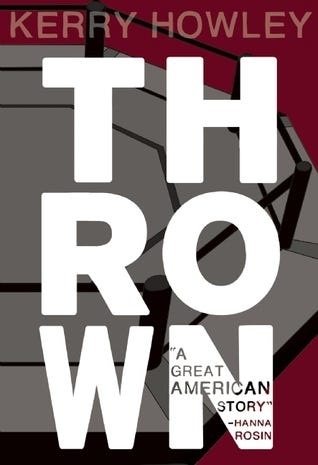
Thrown by Kerry Howley (Sarabande Books)
I have many things to thank Harper’s for this year, but at the top of the list is their decision to run an excerpt from this creative nonfiction book about two mixed martial arts fighters — Sean and Erik — one on the downswing and one just starting out. It’s unlikely I would have bought Thrown otherwise, which would’ve been a shame, because this is electrifying stuff. By inserting herself, or some version of herself, into the narrative, Howley could have distracted readers from her subject matter. But it proves to be a brilliant maneuver that gives readers a much more complete experience. The juxtaposition of the fighters’ lives with the author’s clever (but not facile) turns of phrase helps the reader to more clearly see both MMA and the human dynamics of involvement with that scene. Deft concealment of certain bits of information until the right time helps to build tension but never feels forced or manipulative. The author’s ability to write about actual fights is also superlative. I watch a fair amount of MMA matches and I know that it’s very difficult to describe a fight in an interesting yet accurate way. Howley’s methods in accomplishing this feat provide a clinic for nonfiction and fiction writers alike. Her success is also highly entertaining for readers. Also, despite the possibility here for exploitation, Thrown is a sincere undertaking and the two MMA fighters who form the beating heart of Thrown are treated with a core respect. My favorite nonfiction book of the year, to go alongside my favorite novel, Richard House’s The Kills.
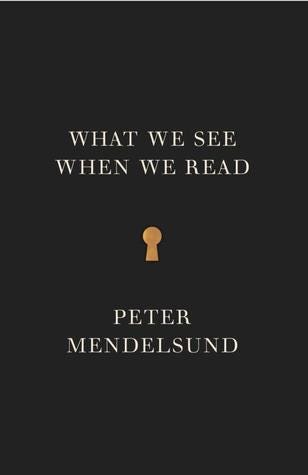
What We See When We Read by Peter Mendelsund (Vintage)
An intriguing book that uses a combination of image and text to explore the reading experience. Sections titled “Memory and Fantasy,” “The Part and the Whole,” and “It Is Blurred” will provoke and delight simultaneously. Visuals like a passage from Kafka’s vision of New York with arrows to indicate a mass of other associations suggest that if you were to thoroughly map certain fictions an even more gnarled mass of arrows would result, signifying an almost infinite wormholes of connections. But the whole book is a kind of down-the-wormhole or rabbit-hole experience, as Mendelsund’s on a continually quest for different image structures to talk about how people read. Stereo-like balance indicators of Dream, Hallucination, Veridical Perception, Reading Imagination exemplify the approach; they’re both practical and whimsical. The author clearly loves the immersive, unique qualities of the reading experience but only someone with Mendelsund’s unique talents in both prose and art could have created this wonderful book.
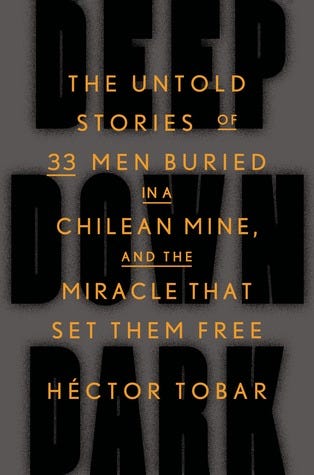
The Chilean mine disaster became sensationalized by the press, as might be expected. This book, which documents the disaster and its aftermath in almost novelistic detail, reclaims the disaster through a humane and thorough approach. The value of words on a page as opposed to fancy infographics and three-dimensional maps in giving us the full story cannot be understated; I don’t really know how, for example, we otherwise could learn as much about the families of the miners. Deep Down Dark starts by following each of the 33 miners from their homes that fateful day and attaches to that narrative a useful and panoramic history of the region and the mine. Once the disaster strikes, the author doggedly follows the story deep inside the mountain with a precision and clarity that makes the events even scarier. The scale of the mining operation — that trucks were driving into the lower levels — is one thing that stuck with me. But also that a slab of stone the height of a 45-story building separated from the inside of the mountain and plunged down through the levels. I read on in horror and fascination, struck equally by the miners’ struggles and the way in which Tobar provided so much useful information and context that I just simply didn’t know before. Along with Thrown, this book deserves all the nonfiction awards.

Tove Jansson: Life, Art, Words by Boel Westin (Sort Of Books)
Finally, I address the Moomins in the room. Specifically, Westin’s excellent authorized biography of the iconic Tove Jansson. An artist and writer, Jansson may be best-known for her Moomin comics and stories — about a family of creatures (people?!) unlike any other — but she also wrote and drew for adults. Westin’s lively, loving book brings Jansson to life on the page. We learn about her artistic parents, her early life, and early successes with her art. In particular, Westin is careful to portray the parents and the creative space in which they, and thus Jansson dwelt, as being pivotal to the flourishing of Jansson’s imagination. In robust detail, Westin also charts the story arc of the iconic writer-artist’s most significant creative accomplishments. Perhaps these are the elements you would expect from a first-rate biography, but they are imbued with extra life by the evident love Westin has for her subject matter. The lavish abundance of photographs and reproductions of Jannson’s art is a wise choice. The saturation of the biography with images on almost every page turns what is already three-dimensional into something much more delectable. This is one biography where you could just look at the pictures if you wanted to — and be richly rewarded.
ART BOOKS

Syllabus by Lynda Barry: Notes From An Accidental Professor (Drawn & Quarterly)
The two-hundred pages of exercises and observations in Syllabus are guaranteed to stimulate your creativity, whether you want to write or draw. Some of the pages feature practical ideas and others are whimsical in the best possible way. “Let’s Draw a Car and Then Let’s Draw Batman” proclaims one page. “Hate Crayon” adorns another, but in an ambiguous “Maybe I actually love Crayons” way. Barry’s approach is non-elitist, democratic, and all about helping you express yourself. But, on another level, this is “just” another gorgeous art book full of Barry’s idiosyncratic, often surreal illustrations. Which means you should buy it even if you’re not looking to spark your creativity.

Leonora Carrington: The Celtic Surrealist by Leonora Carrington et al (Irish Museum of Modern Art)
I love both Carrington’s fiction and art. Someday a book may encompass both. But for now this elegant package focusing on the art is most welcome, especially because it includes a plethora of nonfiction too. The analysis of her art by experts is fascinating enough, but “A Celtic Window” by Carrington’s son Gabriel Weisz Carrington is my favorite. His argument for separating the art from the person — and from her relationship with Max Ernst — convinces, but also provides little personal snapshots. “Whenever my birthday came around,” Gabriel writes sarcastically, “[my mother] would always cook a surrealist cake. It was such an extraordinary event, because this delicious food would levitate at least six feet from the ground, barking ferociously at me.” There have been other coffee table books collecting Carrington’s art, but they’ve always seemed too staid to properly capture the genius of this particular artist. This new one, however, has a welcome wild energy running through it.

Moomin: The Deluxe Anniversary Edition by Tove Jansson (Drawn & Quarterly)
Utterly delightful for children and adults, Jansson’s Moomin comics feature the titular characters, along with cohorts like giant rats, white finger-looking creatures, and others, all engaged in strange and wonderful adventures. Now you can get all of Drawn & Quarterly’s previous slim volumes of Moomin comics in one huge omnibus, complete with several pages of sketches and some lovely full-page full-color compositions. Technically, I guess this is a graphic novel, but I’m treating it as an art book due to its sheer scale and beauty. Moomin and the other creatures Jannson drew are rendered in an appropriately simple style, while the backgrounds are often nuanced and complex. In less skillful hands, this would be fodder for sticking one’s finger down one’s throat in revulsion at the treacly whimsy of it all. However, Tove Jansson was a pragmatist and also, if her work is any indication, a wise person. Beneath the gentle surface of Moomin there is a sly, wicked wit and much non-didactic commentary about the world and people’s place in it. First run in the 1950s in the London Evening News and syndicated around the world, Moomin has a timeless quality. I know that no matter when I return to the Moomin comics and stories, I find something I didn’t see before.

Pitch Black Rainbow: The Art of John Jennings (Rosarium Publishing)
I first saw John Jennings’ artwork on the cover of the highly recommended fiction anthology Mothership: Tales from Afrofuturism and Beyond. Then I tracked down everything I could online, before encountering this stunning coffee table book — which collects some of the best. What do I love about Jennings’ work? The vibrant use of color, the kinetic sense of motion even in static portraits like “Wildseed Lion,” the sense of strength and playfulness in the compositions. Also, as Tananarive Due says in her introduction, “A survey of Jennings’ art is a survey of black popular and political life,” including African American superheroes. Also, it’s just damn beautiful work. You really have to pick this up — and buy it for friends.
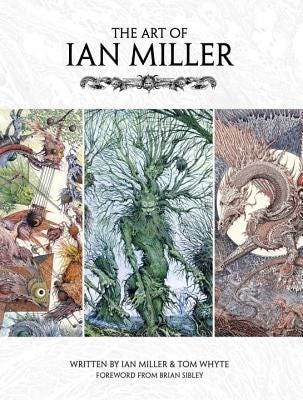
The Art of Ian Miller by Ian Miller & Tom Whyte (Titan Books)
Ian Miller is among the most brilliant and most idiosyncratic of those artists whose oeuvre trends toward the dark, disturbing, and fantastical. This sharp, smart overview features over 300 of his best black-and-white and full-color work. In addition to stunning originals, Miller has created commissioned art for such iconic events as the publication of the “Difference Engine” novella that became the famous novel by Sterling and Gibson. He’s also illustrated avant garde graphic novels by M. John Harrison and created images for Peake’s Gormenghast. The art is uncompromising, sometimes stark, but always also with a trapdoor of black humor and absurdism lurking underfoot. Miller’s commentary is illuminating if sometimes terse. For example, he writes, “I often think of the sea as a powerful animal or beast because of the way it claws and paws the shoreline.” This may seem a simple observation but perfectly explains the sense of almost sentient motion in his Maelstrom illustrations. A lifetime of spectacular achievement can’t be summed up by any one collection, but this book comes close.

Jim: Jim Woodring’s Notorious Autojournal by Jim Woodring (Fantagraphics Books)
Confession time: I never ask myself what Woodring’s art means; I just love his weird critters. I love them so much I could just watch them prancing around doing almost anything and be quite happy. Making a ham sandwich. Getting groceries. Kicking a can. So I picked up Jim expecting perhaps some proto-versions of the acclaimed Woodring style. Instead, a lot of what’s contained therein seems to suggest Woodring’s worldview was always expressing itself in unique surreal ways. Some of the comics that appear to feature him or a him-version are almost Escher-like in their logic. A sequence in which the main character has a series of encounters dressed in his pajamas is particularly interesting. Other sections go all the way to chaotic Dreamville and the wilderness beyond. The value of reading work by artists who allow their subconscious to reign supreme is that you get very little self-censorship, or at least a sense of that kind of freedom on display. Even if you’re not a Woodring super-fan, this is a valuable and entertaining collection.
***

photo by Kyle Cassidy
Potential gift-book selections created by Jeff VanderMeer (and friends) include the Area X hardcover, The Steampunk User’s Manual, The Time Traveler’s Almanac, and Wonderbook: The Illustrated Guide to Creating Imaginative Fiction.









